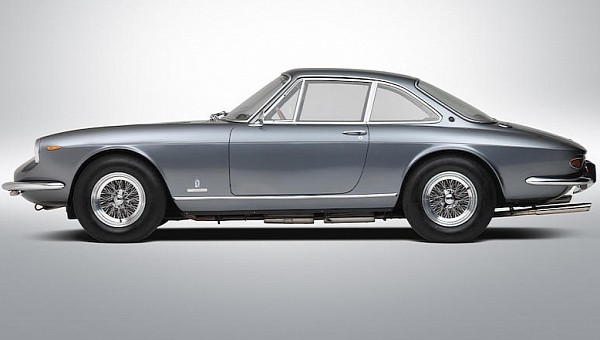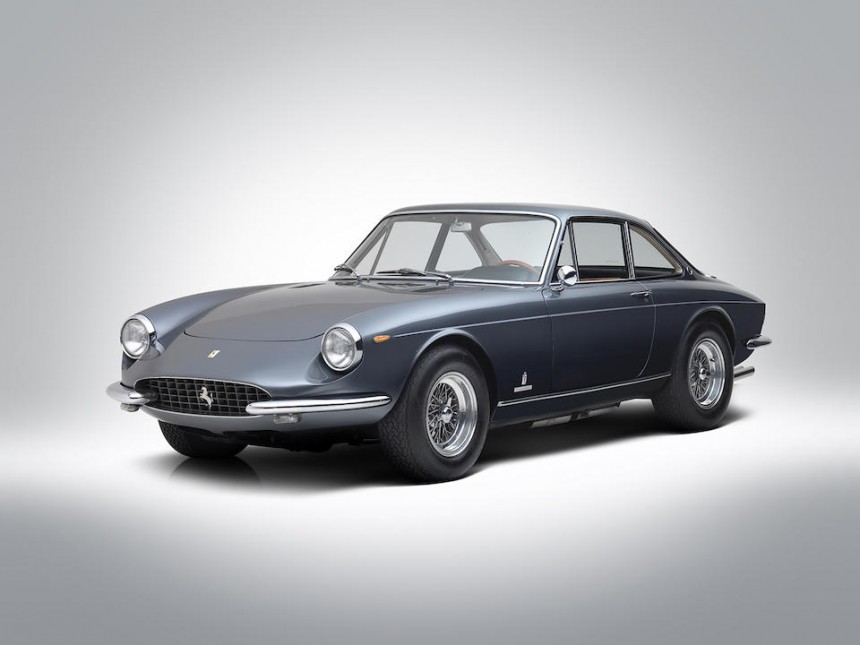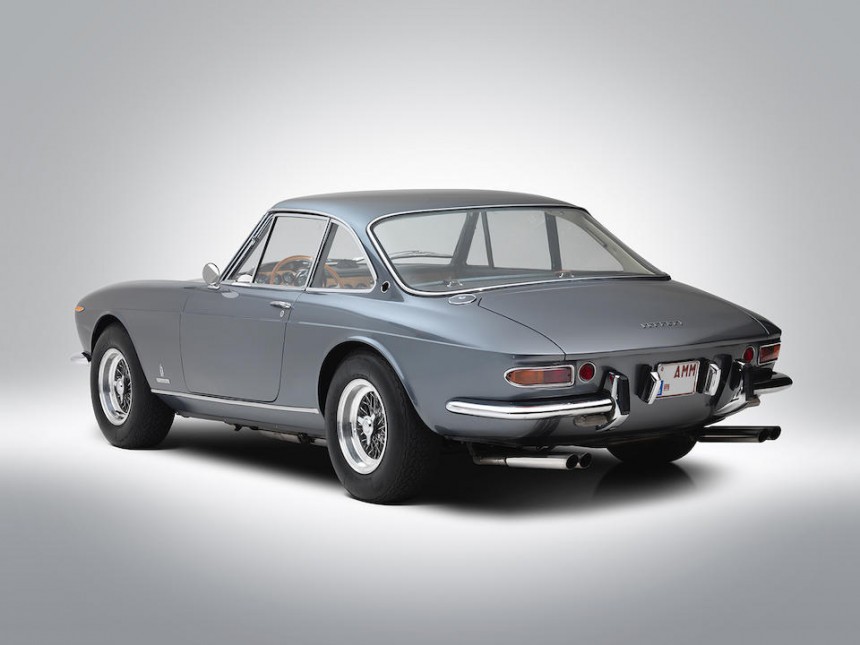Introduced at the 1966 Geneva Motor Show, the 330 GTC was joined by the 330 GTS a few months later at the 1966 Paris Motor Show. Ferrari produced just under 700 examples through 1968, the year when the more powerful and refined 365 series welcomed the 365 GTC and 365 GTS.
Before anything, 330 and 365 both refer to the approximate displacement of each cylinder. From 4.0 liters in the 330, the Gioachino Colombo-designed V12 grew to 4.4 in the 365, which kicked off in grand style with the introduction of the 365 California that ended production after 14 units.
The 365 GT 2+2 followed suit in 1967, then Maranello’s best-known establishment presented the cars we’ll focus on today. More understated than the look-at-me 365 GTB/4 Daytona penned by Leonardo Fioravanti at Pininfarina, the 365 GTC and 365 GTS were designed to appeal to Ferrari’s more senior clientele. The 365 twins feature two hood vents that replaced the fender louvers of their 330 counterparts, resulting in a cleaner look. The Prancing Horse also replaced the model designation from the trunk lid with absolutely nothing, further cleaning up the exterior styling.
Better described as heavy facelifts rather than all-new models, the 365 siblings had their steel chassis upgraded with a wider track up front, a narrower track out back, and reinforced engine mounts. Ferrari also worked its magic on the braking system, and it had also dropped Pirelli for the peeps at Firestone thanks to the American’s brand sponsorship of the Scuderia.
The rubber boots were mounted on 14- by 7-inch cast alloys from Borrani. Disc brakes on every corner, wishbone suspension with telescopic dampers, and a couple of anti-roll bars are featured, along with a 90-liter fuel tank (make that 23.7 gallons). Wire wheels from Borrani were optional, as was air conditioning. The GTS could be spruced up with an optional hard top.
Even though we’re dealing with the best name in the biz, Ferrari couldn’t be bothered to offer a radio as standard. It’s a bit weird, given the starting price of the 365 twins and the status of the people that ponied up incredible stacks of cash to purchase these superb-looking vehicles back in the day.
Slightly heavier than the 330, the 365 had very few novelties to show in terms of interior design. For example, Ferrari relocated the handbrake lever from under the dashboard – right between the accelerator pedal and transmission tunnel - to the area between the seats. The Maranello-based automaker moved the fuse box from the engine bay to the cabin as well.
Equipped with fine leather upholstery and teak veneer, the 365 GTC and 365 GTS both feature two-seat layouts rather than the 2+2 configuration we usually associate with grand tourers. Given that Ferrari already had the Aldo Brovarone-penned 365 GT 2+2 on sale at the same time, giving two extra seats to the 365 GTC and 365 GTS would’ve been completely redundant.
Behind the wood-rimmed steering wheel, you’ll find two large gauges on the sides (the speedometer and tachometer) flanking three smaller gauges (oil temperature and water temperature next to each other and the oil pressure located just below them). To the right of the three-spoke steering wheel, Ferrari neatly integrated the fuel gauge, clock, and ammeter gauge.
Under the hood, the beating heart of the 365 GTC and 365 GTS came in the guise of a 60-degree V12. Gioacchino Colombo finished his 12-cylinder masterpiece in 1947, and Ferrari kept improving it well into the 1980s. The final iteration of the Colombo V12, dubbed F101 E, was used in the 412. Featuring aluminum for the block and heads, the 245 C in the 365 GTC and 365 GTS is a single-overhead-camshaft design with single plug ignition, two ignition coils, two valves per cylinder, and a wet-sump oiling system.
Bored four additional millimeters to 81 millimeters, the 4,390-cc engine boasts a 71-millimeter stroke, an 8.8:1 compression ratio, and Weber carburetors. It cranks out 315 horsepower (320 metric ponies) at 6,600 revolutions per minute and 268 pound-foot (363 Nm) at 5,000 revolutions per minute. Said numbers match those of the 217 B in the 365 California.
Equipped with 205 x 14 tires on every corner, the 365 GTC and 365 GTS feature a five-speed transaxle related to the gearbox used in the 330 series. On the other hand, Ferrari switched from a hydraulic clutch assembly to a cable. The Prancing Horse also switched from half shafts for the rear axle to CV joints. On full song, the GTC hits 250 kilometers per hour (155 miles per hour) as advertised by the Italian automaker. The GTS is much obliged to keep accelerating until the speedometer indicates 245 kph (152 mph).
Sold in the United States of America, the 365 GTC and 365 GTS ended production with fewer than 200 units to their names. The fixed-head coupe originally numbered 168 units, while the much rarer GTS numbered 20.
The 365 GT 2+2 followed suit in 1967, then Maranello’s best-known establishment presented the cars we’ll focus on today. More understated than the look-at-me 365 GTB/4 Daytona penned by Leonardo Fioravanti at Pininfarina, the 365 GTC and 365 GTS were designed to appeal to Ferrari’s more senior clientele. The 365 twins feature two hood vents that replaced the fender louvers of their 330 counterparts, resulting in a cleaner look. The Prancing Horse also replaced the model designation from the trunk lid with absolutely nothing, further cleaning up the exterior styling.
Better described as heavy facelifts rather than all-new models, the 365 siblings had their steel chassis upgraded with a wider track up front, a narrower track out back, and reinforced engine mounts. Ferrari also worked its magic on the braking system, and it had also dropped Pirelli for the peeps at Firestone thanks to the American’s brand sponsorship of the Scuderia.
The rubber boots were mounted on 14- by 7-inch cast alloys from Borrani. Disc brakes on every corner, wishbone suspension with telescopic dampers, and a couple of anti-roll bars are featured, along with a 90-liter fuel tank (make that 23.7 gallons). Wire wheels from Borrani were optional, as was air conditioning. The GTS could be spruced up with an optional hard top.
Slightly heavier than the 330, the 365 had very few novelties to show in terms of interior design. For example, Ferrari relocated the handbrake lever from under the dashboard – right between the accelerator pedal and transmission tunnel - to the area between the seats. The Maranello-based automaker moved the fuse box from the engine bay to the cabin as well.
Equipped with fine leather upholstery and teak veneer, the 365 GTC and 365 GTS both feature two-seat layouts rather than the 2+2 configuration we usually associate with grand tourers. Given that Ferrari already had the Aldo Brovarone-penned 365 GT 2+2 on sale at the same time, giving two extra seats to the 365 GTC and 365 GTS would’ve been completely redundant.
Behind the wood-rimmed steering wheel, you’ll find two large gauges on the sides (the speedometer and tachometer) flanking three smaller gauges (oil temperature and water temperature next to each other and the oil pressure located just below them). To the right of the three-spoke steering wheel, Ferrari neatly integrated the fuel gauge, clock, and ammeter gauge.
Bored four additional millimeters to 81 millimeters, the 4,390-cc engine boasts a 71-millimeter stroke, an 8.8:1 compression ratio, and Weber carburetors. It cranks out 315 horsepower (320 metric ponies) at 6,600 revolutions per minute and 268 pound-foot (363 Nm) at 5,000 revolutions per minute. Said numbers match those of the 217 B in the 365 California.
Equipped with 205 x 14 tires on every corner, the 365 GTC and 365 GTS feature a five-speed transaxle related to the gearbox used in the 330 series. On the other hand, Ferrari switched from a hydraulic clutch assembly to a cable. The Prancing Horse also switched from half shafts for the rear axle to CV joints. On full song, the GTC hits 250 kilometers per hour (155 miles per hour) as advertised by the Italian automaker. The GTS is much obliged to keep accelerating until the speedometer indicates 245 kph (152 mph).
Sold in the United States of America, the 365 GTC and 365 GTS ended production with fewer than 200 units to their names. The fixed-head coupe originally numbered 168 units, while the much rarer GTS numbered 20.











































